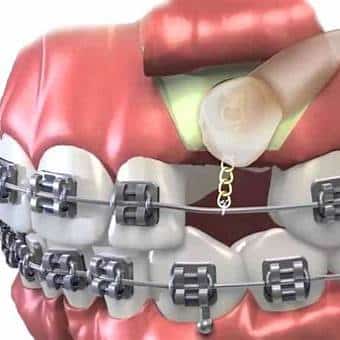The Expose and Bond procedure is a common and effective treatment used when a tooth, usually a canine , fails to erupt (break through the gums) on its own. Canines play a critical role in the bite and appearance of the smile, and are among the last of the front teeth to come in. When one doesn’t emerge naturally, it’s often considered impacted, meaning it is stuck beneath the gum or bone and needs help to be guided into its proper position.

Why Is It Needed?
An impacted tooth may remain trapped in the jawbone or soft tissue due to crowding, unusual positioning, or genetic factors. If left untreated, it can cause problems such as:
- Misalignment of surrounding teeth
- Damage to roots of nearby teeth
- Formation of cysts around the impacted tooth
- Gaps in the smile or improper bite
Orthodontists often identify this issue during braces treatment, and they may refer you to an oral surgeon to perform the Expose and Bond procedure as part of the overall orthodontic plan.
What Happens During the Procedure?
The procedure can be performed under local anesthesia or sedation depending on the patient’s age, comfort level, and the complexity of the case.
A CBCT is usually needed before the procedure to determine the position of the tooth and its relationship with adjacent teeth to choose the best surgical access
- Accessing the Tooth: During the procedure, the oral surgeon gently lifts the gum tissue to expose the impacted tooth. In some cases, a small amount of bone may also be removed to fully uncover the tooth.
- Attaching the Bracket: Once the tooth is visible, a small orthodontic bracket is bonded (glued) to the tooth. This bracket has a delicate gold or metal chain attached to it.
- Repositioning the Gum: The gum is then either sutured (stitched) back in place around the bracket, or in some cases, left slightly open to allow the chain to extend toward the orthodontic appliance.
- Orthodontic Guidance: Over the following months, the orthodontist will gradually apply gentle traction to the chain through braces. This slowly guides the tooth into its correct position in the dental arch.
What Is Recovery Like?
Most patients recover quickly from the Expose and Bond procedure. Mild swelling, soreness, or discomfort is normal and usually manageable with over-the-counter pain relievers. Patients can typically resume normal activities the next day.
We’ll provide specific instructions on how to care for the surgical site, including:
- Eating soft foods for a few days
- Keeping the area clean to avoid infection
- Managing any discomfort with medication or ice packs
Follow-up appointments with both the oral surgeon and the orthodontist are essential to monitor healing and ensure the tooth is moving as planned.